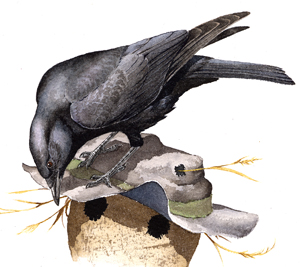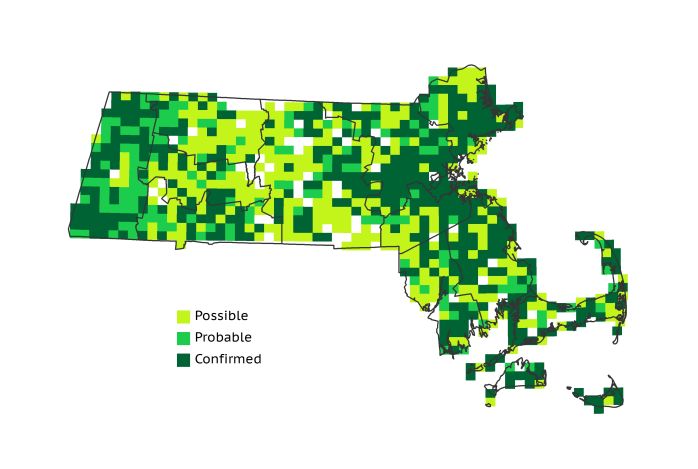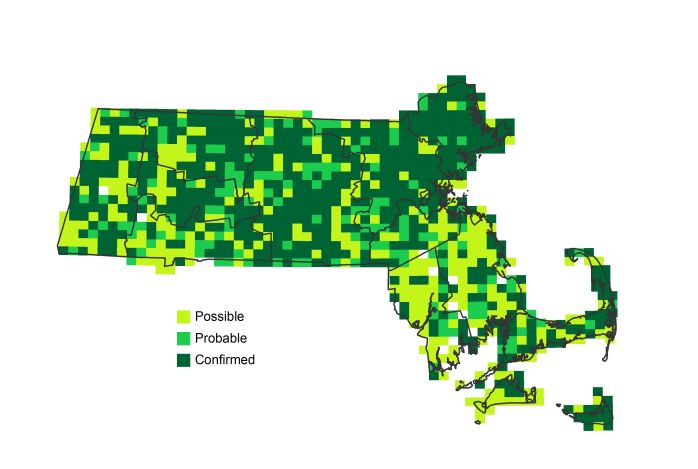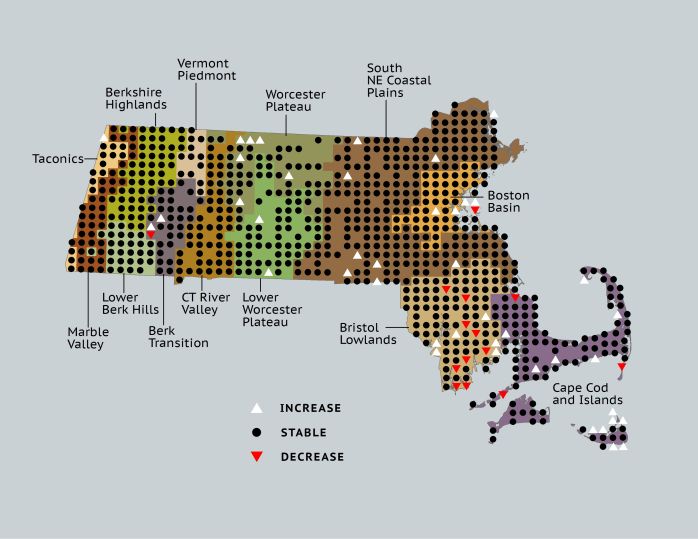Find a Bird
American Crow
Corvus brachyrhynchos

Nearly ubiquitous and stable
“It is better to fall among crows than flatterers; for those devour only the dead – these the living.” – Antisthenes
American Crows have received precious little flattery throughout their history of interacting with humankind. Hunters detest their depredations on waterfowl nests, and farmers curse their meals of corn and sorghum taken from the field. Still, crows demand a certain grudging admiration from even among their staunchest critics. Since crows are clever enough to open our garbage bags and use our cars to crack open nuts, it is small wonder that these familiar glossy black omnivores have become so common in the Commonwealth.
Historic Status
The American Crow has “always been here,” in the colloquial parlance of Massachusetts residents, and for most of its coexistence with European settlers and their descendants, has also been disliked. “Persecuted as it is,” wrote William Peabody, ” [it] still abounds in Massachusetts, as is testified by the scare crows and other ornamental devices that embellish our fields in the spring” (Peabody 1839). There is one group of Bay Staters in particular that has long expressed ire toward this species, and that is the farmers. To the above, Peabody added, “Farmers are very bitter in their feeling toward the crow, but perhaps they would be more moderate in their resentment at his depredations, if they were aware, that the cut-worm has the benefit of all their efforts to destroy the crow. Whether that voracious grub will feel any gratitude for this protection, may be doubted.” The state’s population of breeding American Crows did not waver much over the next century and a half.
Atlas 1 Distribution
Resourceful, adaptable, and clever, American Crows responded to reduced human persecution by consolidating their presence in all corners of the state by the time of Atlas 1. Crows were just shy of ubiquitous from the western border of the state to the Worcester Plateau, where they were still widespread but reported in only 81% of blocks. American Crow occupancy rose again in the more suburbanized and urbanized areas of the Coastal Plains and Boston Basin, as the species profited from the abundant food waste produced by humans. Although there were some blocks where no crows were found in the Bristol/Narragansett Lowlands and the Cape and Islands, American Crows were still much more often present than not throughout these regions.
Atlas 2 Distribution and Change
Despite considerable mortality from the mosquito-borne West Nile virus in the late 1990s and early 2000s, American Crows came back stronger than ever by the time of Atlas 2. Few blocks west of the Coastal Plains lacked evidence of breeding American Crows in the second Atlas. In the eastern part of the state, the trend was also one of stability or slight increase; only in the Bristol/Narragansett Lowlands did American Crows disappear from more blocks than they colonized. This small fluctuation is barely a drop in the bucket of the American Crow’s impressively broad breeding distribution, of which Massachusetts itself is only a tiny part.
Atlas 1 Map

Atlas 2 Map

Atlas Change Map

Ecoregion Data
Atlas 1 | Atlas 2 | Change | ||||||
Ecoregion | # Blocks | % Blocks | % of Range | # Blocks | % Blocks | % of Range | Change in # Blocks | Change in % Blocks |
Taconic Mountains | 15 | 93.8 | 1.7 | 20 | 80.0 | 2.0 | 1 | 6.7 |
Marble Valleys/Housatonic Valley | 39 | 100.0 | 4.5 | 39 | 100.0 | 3.9 | 0 | 0.0 |
Berkshire Highlands | 53 | 96.4 | 6.1 | 54 | 98.2 | 5.5 | 0 | 0.0 |
Lower Berkshire Hills | 28 | 100.0 | 3.2 | 30 | 96.8 | 3.0 | 0 | 0.0 |
Vermont Piedmont | 16 | 94.1 | 1.8 | 17 | 100.0 | 1.7 | 0 | 0.0 |
Berkshire Transition | 35 | 92.1 | 4.0 | 39 | 97.5 | 3.9 | 1 | 3.2 |
Connecticut River Valley | 55 | 98.2 | 6.3 | 63 | 96.9 | 6.4 | 0 | 0.0 |
Worcester Plateau | 63 | 80.8 | 7.2 | 87 | 98.9 | 8.8 | 6 | 12.5 |
Lower Worcester Plateau | 64 | 86.5 | 7.4 | 80 | 100.0 | 8.1 | 2 | 3.7 |
S. New England Coastal Plains and Hills | 250 | 92.6 | 28.7 | 279 | 98.6 | 28.2 | 9 | 4.0 |
Boston Basin | 50 | 89.3 | 5.7 | 54 | 96.4 | 5.5 | 3 | 5.5 |
Bristol and Narragansett Lowlands | 96 | 90.6 | 11.0 | 98 | 86.0 | 9.9 | -3 | -3.0 |
Cape Cod and Islands | 106 | 77.9 | 12.2 | 130 | 90.3 | 13.1 | 10 | 8.3 |
Statewide Total | 870 | 89.8 | 100.0 | 990 | 95.5 | 100.0 | 29 | 3.5 |
Notes
In accordance with Atlas increases, the American Crow shows a significant increasing Breeding Bird Survey trend in Massachusetts, in the New England/Mid-Atlantic Region, and in the Eastern US overall.



